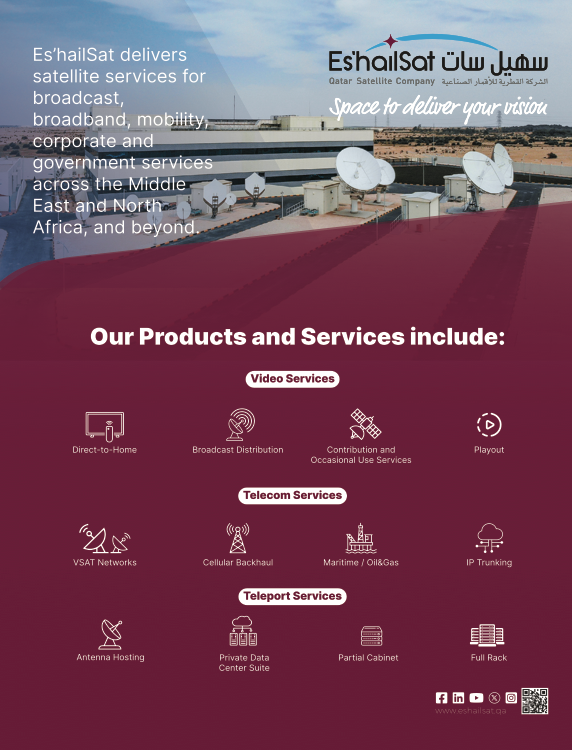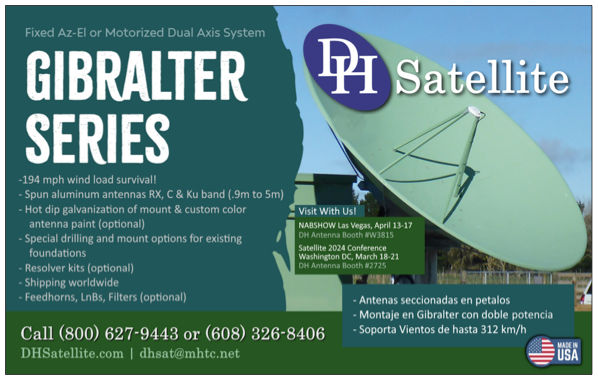A leap into the future of Space Domain Awareness
“Don’t find fault, find a remedy:
anyone can complain.”
— Henry Ford
Nearly five years ago, in 2019, as three Ph.D. students wondered what lay ahead for them, the world was witnessing the dawn of a new age for space. A few space tech companies cropped up here and there, often characterized by big ambitions, unsettling ideas and lots of buzzwords.
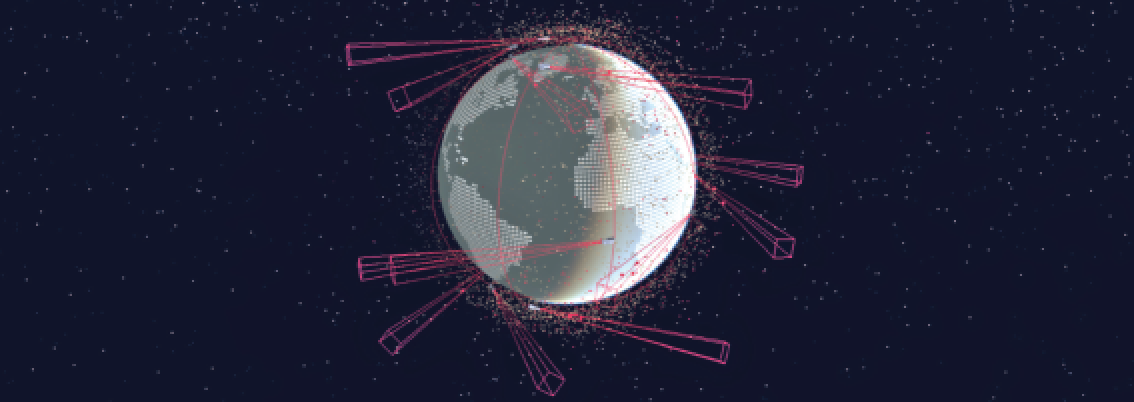
Already then, it was clear to see that space was a radix of wonder for the public who gazed in awe at its infinity; an object of curiosity for scientists who recorded the first image of a supermassive black hole that year; plus a source of headaches for lawmakers. After all, it was an industry that was growing out of pace with regulations, with more than 5,000 human-made objects in space, less than half of which were active satellites.
However, without space traffic rules and a promise of 100,000 new satellites to be launched by 2030, how could humanity keep up without some form of coordination? The space ecosystem was vulnerable to security threats and doomed to over congestion.
Restless as Ph.D. students are, not taking transformative action was not an option. The first realization was that reliable information was a bottleneck for the satellite operations industry and automation had to play a part in the solution.
The second realization was that the business opportunity was tremendous — 100,000 new satellites in a 10 trillion euros market could certainly not be ignored.
The last realization was that there was no excuse for not acting on the opportunities presented by the expansion of space.
There it started — the three, soon-to-be-founders wrapped up their degrees and, five years later, Vyoma is on the verge of launching their first, space-based surveillance system for monitoring space traffic.
Fast-Forward To Today — What Changed?
First of all, the understanding solidified that, in order to make operational decisions, new data that is complementary to that of existing (ground) sensors is required. This means being able to observe smaller and faint objects that are invisible to the ground, ten-to-one-hundred times more frequently, and being able to detect, early enough, anomalous patterns of behaviors in space.
For those purposes, there needed to be a fresh point of view and new sensor technology to be built around these requirements — at affordable cost.
This acknowledgement led to the design and development of a powerful telescope constellation for in-loco observations. The telescope instrument is characterized by a large-aperture diameter, that captures as much light as possible, to observe thousands of Sun-illuminated objects as small as a few centimeters, as often as 30 times per day.
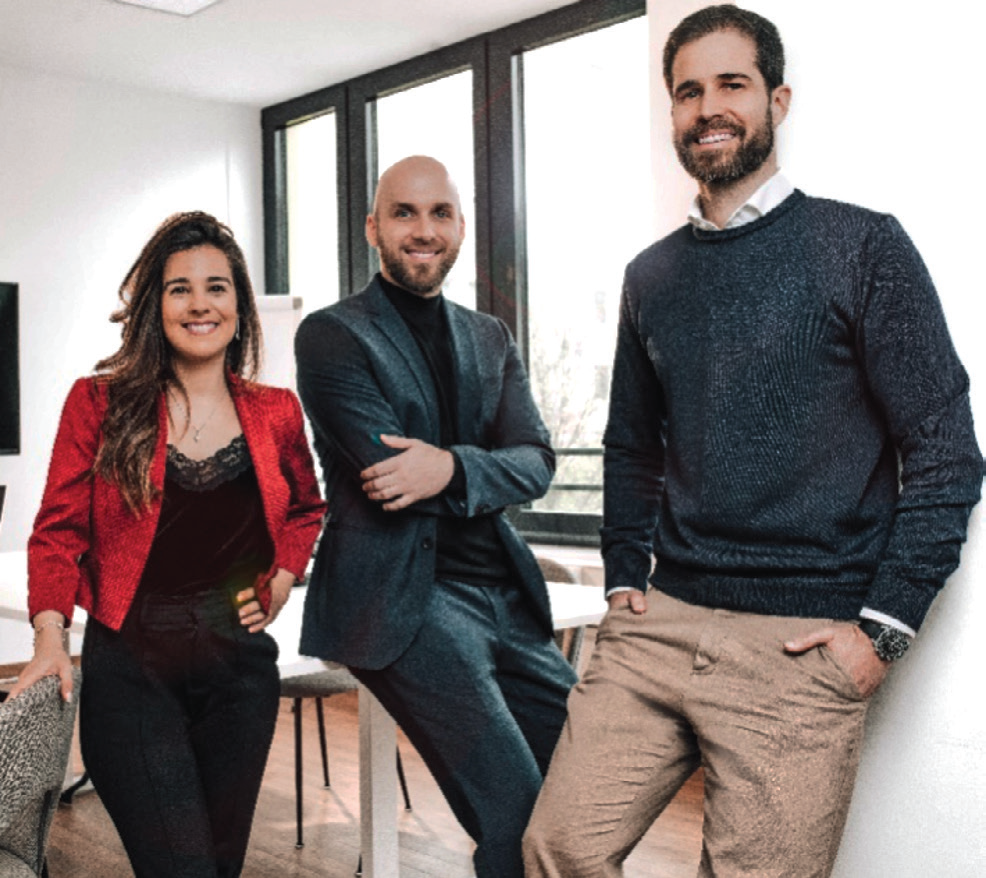
Vyoma’s founding team. From left to right: Dr. Luisa Buinhas,
Christoph Bamann and Dr. Stefan Frey.
Rather than being stationary on the ground, this constellation of 12 telescopes will fly in a Low Earth Orbit (LEO) and have a dedicated surveillance operational strategy. The first unit of this constellation will be launched in early 2025, on a SpaceX vehicle.
The information from the space-based space surveillance sensors is used to feed predictive algorithms that underpin the safety services Vyoma provides to customers — from predictions of close approaches all the way to automated maneuver planning, simplified at the touch of a button. By empowering satellite operators to efficiently manage their satellite fleets, Vyoma has put the human user at the center of these developments.
With a few dozen customer satellites already under the company’s responsibility, Vyoma offers a user interface that is seamless and fluid (time- evolution of objects in a slider, ‘drag-and-drop’ features). Concise, smart graphics minimize user mental load and maximize responsiveness.
A pass predictor helps operators schedule their onboard activities, such as space-ground communications opportunities. Moreover, on their account, users can screen trajectories of their assets against a full catalog of space objects for detecting upcoming collision and fully customize the satellite and mission constraints for maneuver planning: from the obvious propulsion system type, to maneuver direction preferences, to thresholds for the triggering of an avoidance maneuver.
Naturally, these efforts came at the back of a remarkably successful Seed round, which brought the overall volume of capital raised to over 16 million euros. Notably, a third of this investment came from the European Investment Fund.
Human resources were also crucial for achieving many of the milestones and the company’s expert engineering and business team now counts with 30 Vyomanauts.
The company also gained recognition from European governments, by closing deals with defense institutions, participating in EU Commission and European Space Agency (ESA) programs for Space Domain Awareness (SDA) technology and by being awarded two, free launches by the German Aerospace Center (DLR). Two contracts with the Bavarian government for technology development, valued at 1.5 million euros, were also closed.
What Is In Store For 2024
2024 will be the year where Vyoma lays the ground (or nest, so to speak) for the upcoming launch of the first “bird.” In a coordinated sequence of activities, the telescope and satellite will undergo a battery of tests to prove that they can withstand the launch loads, without compromising performance or the integrity of the sensitive components. The telescope will, thereafter, be integrated onto the satellite bus, re-tested and shipped to the launch site.
At the same time, the ground segment will be further advanced in preparation for on-orbit operations. Vyoma’s spacecraft will communicate with a global network of ground antennas, to bring space-based SDA data to the market within minutes of the data being recorded.
This communications link will be tested in the second half of 2024.
The intricacies of the in-space surveillance operations require a dedicated mission planning system that can cope with the performance requirements within the constrained onboard resources (such as power availability and memory storage).
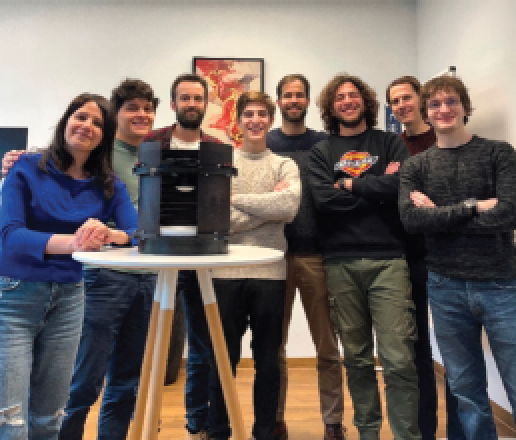
Left: the Vyoma engineering team showcasing the optical instrument
(one-to- space environment, making satellite operational decisions more
robust than ever. one model) that will fly onboard the first satellite.
At right: the first-generation spacecraft, in a deployed baffle configuration.
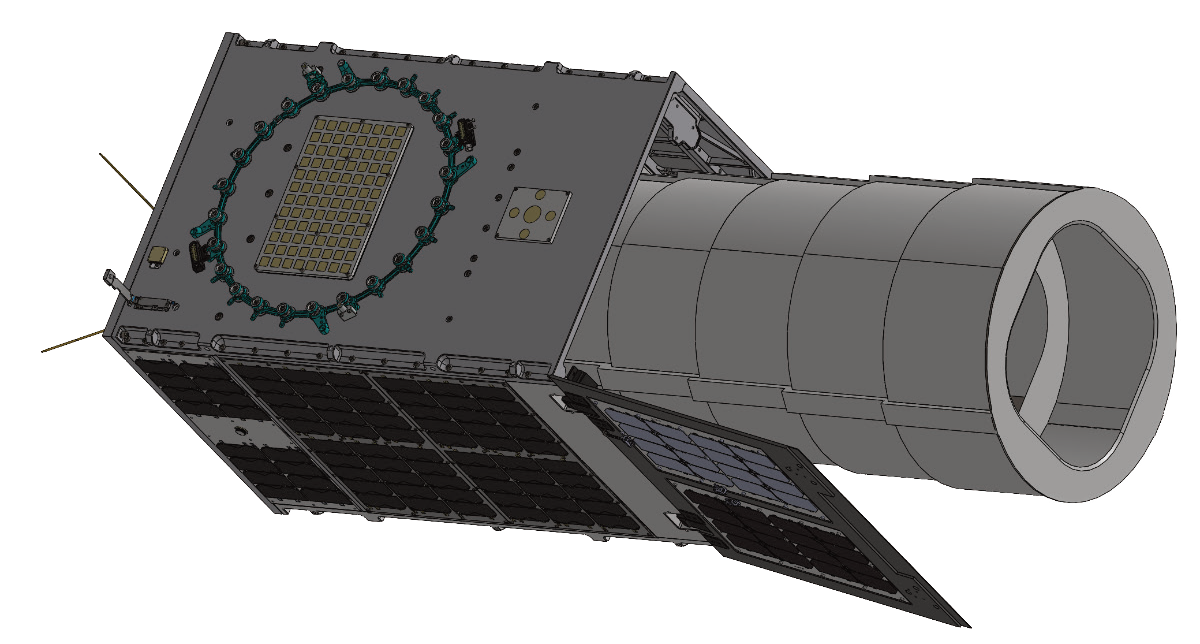
The development of algorithms for optimal scheduling of onboard activities is well underway. Vyoma’s operations personnel will start to receive training at the end of the year.
Another important development is the connection between Vyoma’s user platform and the tasking of the space sensors.
Although ground-based sensors are already integrated with the platform (i.e., users can at any time book them for recording images of space objects), users in the future will also be able to task onboard sensors to follow an object or event of interest.
Finally, although no less important, Vyoma’s cataloging abilities will be matured in the upcoming months — initially using synthetic data and after the launch of the first telescope, using real data. Cataloging refers to the ability to identify new and existing objects and match them to an entry in a database, based on an observation made at a bespoke point in time.
Naturally, catalog entries go beyond the name and orbit of the object, but include the country of origin, nature (e.g., satellite vs. rocket body, civilian vs. governmental), dimensions (including area-to-mass ratios), among others.
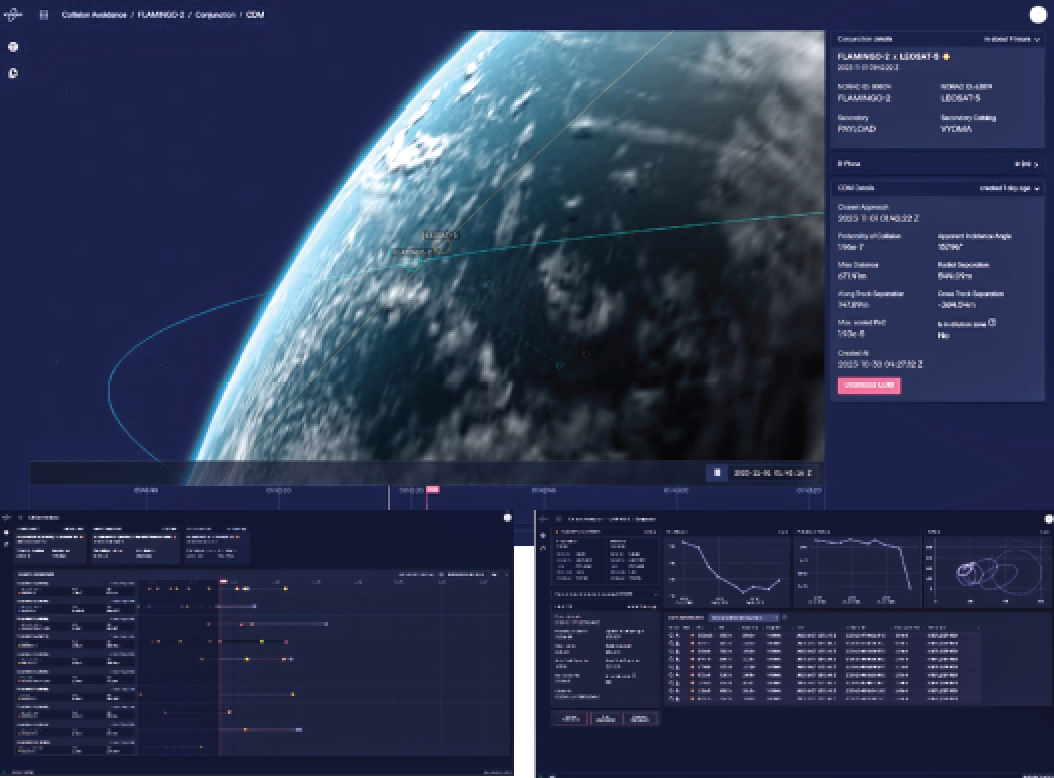
Vyoma web platform.
What is extraordinary about this catalog, however, is the size: from space, Vyoma’s optical telescope can observe the majority of objects in the LEO orbit — an unprecedented feat, given that existing, ground-based systems only track 3% of space objects. With this catalog, Vyoma can build a real-time, digital twin of the space environment, making satellite operational decisions more robust than ever.
On the commercial front, Vyoma plans to expand the customer base across both the civilian and governmental sectors.
“Already now we are in touch with pan-European space force representatives, who manifested the importance of reliable data for SDA from European sources for space defense and geostrategic autonomy in intelligence gathering,” said Dr. Stefan Frey, the CEO of the company.
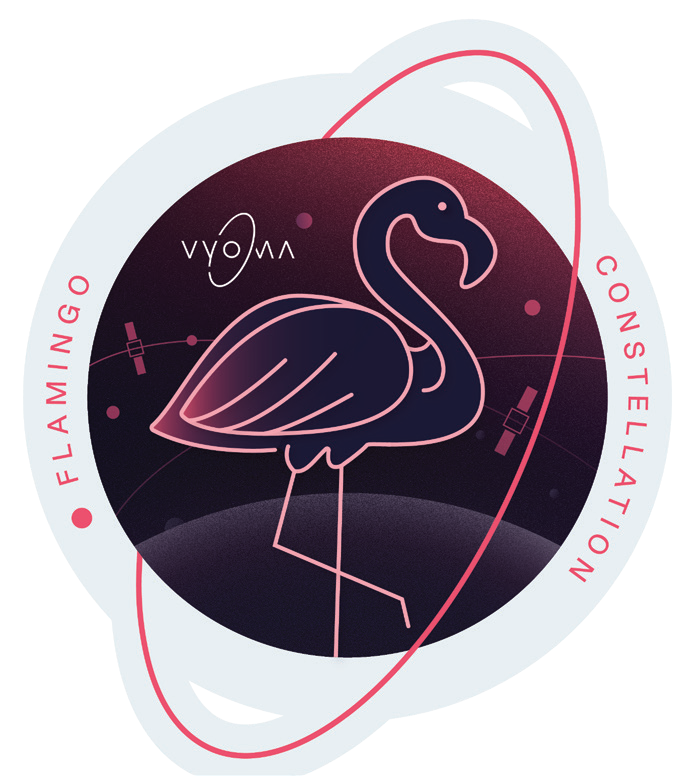
Furthermore, Vyoma plans to start rolling out the firm’s flight dynamics and mission planning services being developed for the company’s own missions additionally to customers, such that they, too, can benefit from a high level of automation in satellite operations.
What The Future Holds Post-2024
The launch of the first satellite will certainly be the most exciting moment in early 2025. After the commissioning phase, the satellite will start producing the first images, enhancing Vyoma’s current space safety services with improved data. Vyoma counts on two further launches within a year after that event and the remaining satellites will be launched up until 2028. With the full constellation, Vyoma will bring to the industry a complete, zero-latency picture of space. Only then can satellite operations be fully automated in a trustworthy manner.
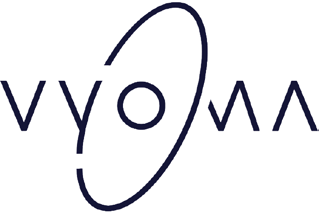
Profoundly transformative for the space operations industry and spearheading European intelligence sovereignty efforts, Vyoma is on the path to becoming a critical infrastructure of the continent.
The path ahead is not trivial and, as with any young company, there will be headwinds. However, bringing change about to an industry in need of a metamorphosis is a long-term journey. As Henry Ford conveyed — such will not happen, unless you leave the comfort zone and take the lead in paving the way for the future.
www.vyoma.space

Dr. Luisa Buinhas
Author Dr. Luisa Buinhas, the Chief Program Officer, Vyoma, holds a Ph.D. in Aerospace Engineering (from the University of the German Federal Armed Forces) and a Master’s degree (TU Delft), also in Aerospace Engineering. She was involved in mission studies for satellite constellations for six years for DLR, in Germany, and spent six months at MIT as a research intern. She holds an Amelia Earhart Fellowship from 2016 and is part of the Space Traffic Management technical committee of the International Astronautical Federation. Currently, she oversees the space program at Vyoma and is responsible for system engineering developments.


